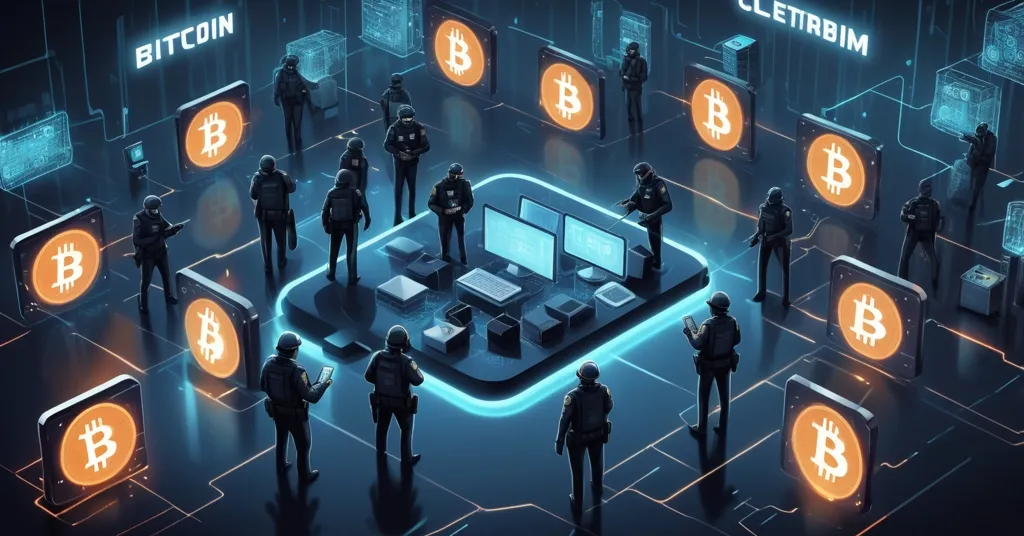Europol Busts Latvian Cybercrime Hub in Operation SIMCARTEL: Crypto Faces Fraud Wake-Up Call

Europol Smashes Latvian Cybercrime Hub in Operation SIMCARTEL: A Wake-Up Call for Crypto and Blockchain
European law enforcement has delivered a devastating strike to the dark underbelly of cybercrime, dismantling a Latvian-based platform that powered phishing scams, investment fraud, and a host of other digital crimes. Through the international effort known as Operation SIMCARTEL, Europol and its allies have arrested suspects, seized massive troves of illicit tech, and frozen substantial funds—proving that online anonymity for criminals isn’t a given, even in the murky corners of the internet.
- Operation SIMCARTEL: Europol-led crackdown on a Latvian cybercrime-as-a-service (CaaS) platform fueling global fraud.
- Major Bust: Seven arrests, 1,200 SIM box devices with 40,000 SIM cards seized, and millions in funds frozen.
- Victim Toll: Over 3,200 individuals hit, with losses topping €4.9 million in Austria and Latvia alone.
The Scale of the Scam: A Global Fraud Factory
This wasn’t just a small-time hustle. The Latvian operation acted as a full-blown cybercrime-as-a-service (CaaS) platform, essentially a criminal supermarket where bad actors could buy or rent tools to pull off scams at an industrial scale. For those new to the term, CaaS means offering ready-made solutions like hacking software, stolen data, or anonymous communication systems to anyone with the cash to pay—no tech skills required. This particular hub enabled the creation of over 49 million fake online accounts, which were then used for everything from phishing campaigns (those malicious messages tricking you into spilling personal details) to investment frauds promising sky-high returns that never materialize. Worse still, the platform supported extortion, migrant smuggling, and even the distribution of child sexual abuse materials. If there was a digital crime to commit, these folks were handing out the blueprints.
Two websites at the core of this operation—gogetsms[.]com and apisim[.]com—have now been seized and branded with law enforcement banners. GoGetSMS, for instance, shamelessly marketed itself as a provider of “fast and secure temporary phone numbers,” claiming access to 10 million numbers and verification capabilities for over 160 online services. It was a digital disguise kit, letting criminals set up fake profiles on social media, banking platforms, or cryptocurrency exchanges without ever showing their real faces. But not everyone was thrilled with their shady service. One user aired their frustration on Trustpilot, saying:
“Tried multiple times, wasted both time and money. Support is completely unresponsive – no help, no refund, nothing.”
Turns out even crooks can’t dodge the curse of lousy customer support. But while some griped about bad deals, the real pain was felt by thousands of victims. In Austria, over 1,700 cyber fraud cases linked to this network racked up €4.5 million (about $5.25 million) in losses. Latvia, where the operation was based, reported 1,500 cases with losses of €420,000 ($489,000). Across borders, more than 3,200 individuals suffered from this criminal machine’s global reach. For more details on this massive takedown, check out the report on Europol’s operation against the Latvian fraud network.
Technology Behind the Fraud: SIM Farms and Digital Masks
Beyond the staggering numbers, the tech powering this scam was just as chilling. Europol called the setup “technically highly sophisticated,” a carefully built system designed to keep perpetrators hidden and untouchable. At its heart were SIM farms—think of them as automated setups mimicking thousands of disposable burner phones, but scaled up to a warehouse level of operation. These systems used SIM box devices to manage massive pools of phone numbers, allowing scammers to bypass security measures like two-factor authentication (2FA). For the uninitiated, 2FA is that extra layer of protection where a code gets sent to your phone to verify your identity. When criminals use SIM farms to control fake numbers, they can intercept those codes, access accounts, and wreak havoc—all while staying anonymous.
Law enforcement hit hard, confiscating 1,200 SIM box devices packed with over 40,000 active SIM cards. They also dismantled five servers critical to the operation. Europol’s own words paint a grim picture of the platform’s capabilities:
“The criminal network and its infrastructure were technically highly sophisticated and enabled perpetrators around the world to use this SIM-box service to conduct a wide range of telecommunications-related cybercrimes, as well as other crimes.”
Operation SIMCARTEL wasn’t a lone wolf effort. It showcased international teamwork at its finest, uniting forces from Austria, Latvia, Finland, and Estonia, with backup from Eurojust, the EU’s criminal justice cooperation agency. The haul? Seven suspects behind bars, including five Latvian nationals, along with €431,000 ($502,000) in bank accounts and €266,000 ($310,000) in cryptocurrency accounts frozen. That crypto piece hits close to home for us. It shows how digital currencies are a double-edged sword—exploited by scammers for laundering dirty money, yet their blockchain transparency can sometimes help authorities track and seize funds if they’ve got the right tools.
Crypto in the Crosshairs: How Scammers Exploit Decentralization
Let’s zero in on why this matters to our Bitcoin and blockchain community. Platforms like this Latvian hub are a goldmine for crypto-related fraud. The fake accounts they churn out often fuel scams tailored to our space—think fraudulent exchanges that disappear after you deposit funds, phishing sites posing as wallet providers to steal your private keys, or Ponzi schemes masquerading as shiny new DeFi projects. It’s not hard to picture: a scammer uses a temporary number from GoGetSMS to verify a fake Twitter account, then promotes a “can’t-miss” NFT drop that’s just a digital trap. By the time victims notice their wallets are drained, the perp’s long gone, hidden behind layers of anonymity.
This isn’t hypothetical. Reports of rug pulls in DeFi—where developers abandon projects after hyping them with fake social media accounts—have spiked in recent years, often tied to these kinds of CaaS platforms. It’s a gut punch to the ethos of decentralization we hold dear. Bitcoin was built to disrupt the status quo, to give power back to individuals, not to bankroll the scum of the internet. And while altcoins like Ethereum drive innovation with smart contracts and decentralized apps, they’re just as vulnerable to being weaponized if we ignore security. The €266,000 in frozen crypto from this bust proves law enforcement is catching up, often using tools like Chainalysis to trace on-chain transactions. But that traceability cuts both ways—privacy advocates rightly argue it risks eroding the autonomy that makes crypto revolutionary.
The Bigger Picture: A Growing Cybercrime Plague
Zooming out, this Latvian operation is just one head of a hydra. Cybercrime-as-a-service has exploded over the past decade, evolving from underground hacker forums to polished platforms that cater to anyone with a PayPal account or a stack of Bitcoin. These services lower the barrier to entry, turning script kiddies into full-blown fraudsters overnight. Operation SIMCARTEL follows a string of similar busts, yet for every takedown, new platforms sprout up, often in jurisdictions where EU or US authorities can’t touch them. It’s a game of whack-a-mole, and we’re nowhere near winning.
So, let’s play devil’s advocate for a moment. Are we, as a crypto community, doing enough to stop our tech from becoming a criminal’s playground? Bitcoin maximalists like myself champion privacy and freedom, but when those principles shield fraudsters, don’t we bear some responsibility? Look at Monero—its privacy features are a godsend for dissidents in oppressive regimes, yet they’re also a magnet for illicit transactions. Should we push for solutions like optional transparency tools or better on-chain analytics for high-risk activities, without gutting decentralization? I’m not advocating for Big Brother oversight—screw that—but pretending anonymity doesn’t have a dark side is how we lose credibility. We need to balance freedom with accountability, or regulators will do it for us in ways we won’t like.
What’s Next for Cybercrime Defense and Crypto’s Role?
Props to Europol and their partners for landing this blow. Freezing both bank and crypto accounts shows they’re adapting to the digital frontier, even if they’re still outpaced by the sheer scale of CaaS networks. For Bitcoin and blockchain enthusiasts, this is a stark reminder to build with security front and center. Ethereum’s smart contract developers, DeFi innovators, and even NFT creators need to prioritize scam-proofing over just pumping out the next hot thing. And for us Bitcoin diehards, it’s a call to support open-source tools that spot fraud early—think wallet trackers or community-driven blacklists—without compromising our core values.
Bitcoin fraud prevention and blockchain security risks aren’t just buzzwords; they’re existential challenges. We’re crafting the future of finance, but that future’s worthless if it’s overrun by scammers using our own tools against us. Effective accelerationism—building fast but building right—means educating users to spot red flags, like unsolicited crypto investment pitches or too-good-to-be-true yields. It also means staying one step ahead of criminals, whether through tech or sheer vigilance. Operation SIMCARTEL is a win, but it’s not the war. The fight against cybercrime is as much ours as it is law enforcement’s. Stay sharp, question everything, and let’s keep pushing for a decentralized world that doesn’t give fraudsters a free ride.
Key Takeaways and Questions
- What was the Latvian cybercrime platform’s main operation?
It ran as a cybercrime-as-a-service (CaaS) hub, supplying tools like SIM farms and temporary phone numbers to create over 49 million fake accounts for phishing, investment fraud, and other crimes. - How does this takedown affect the cryptocurrency space?
It highlights how CaaS platforms enable crypto scams like fake exchanges and wallet phishing, while also showing blockchain’s traceability can assist in freezing illicit funds, as with the €266,000 seized. - Is Operation SIMCARTEL a turning point in fighting cybercrime?
It’s a notable victory with arrests and asset seizures, but it’s far from a fix—new CaaS networks will rise, and the crypto community must remain proactive against tech misuse. - Should Bitcoin and blockchain prioritize privacy or accountability after such incidents?
This case sparks debate on balancing privacy—a core crypto value—with mechanisms to deter fraud, without sacrificing decentralization or inviting overregulation. - What can the crypto community do to combat cybercrime risks?
Focus on building secure systems, supporting open-source fraud detection tools, and educating users to spot scams, ensuring innovation doesn’t outpace safety.



